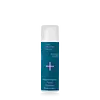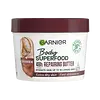i+m Fluid Equalize Versus Garnier Body Superfood
What's inside
What's inside
 Key Ingredients
Key Ingredients

No key ingredients
 Benefits
Benefits

 Concerns
Concerns

 Ingredients Side-by-side
Ingredients Side-by-side

Water
Skin ConditioningAloe Barbadensis Leaf Juice
Skin ConditioningGlycerin
HumectantCetearyl Alcohol
EmollientGlyceryl Stearate Citrate
EmollientPrunus Armeniaca Kernel Oil
MaskingIllite
AbrasiveSodium Hyaluronate
HumectantMalva Sylvestris Extract
AstringentBuddleja Officinalis Flower Extract
UV FilterSimmondsia Chinensis Seed Oil
EmollientArnica Montana Flower Extract
MaskingOlea Europaea Fruit Oil
MaskingSodium Levulinate
Skin ConditioningXanthan Gum
EmulsifyingAlcohol
AntimicrobialSambucus Nigra Flower Extract
RefreshingMelissa Officinalis Leaf Extract
Skin ConditioningKaolin
AbrasiveTocopherol
AntioxidantHelianthus Annuus Seed Oil
EmollientMontmorillonite
AbsorbentSodium Anisate
AntimicrobialLevulinic Acid
PerfumingSodium Phytate
Cetyl Alcohol
EmollientGlyceryl Caprylate
EmollientPropanediol
SolventRosmarinus Officinalis Leaf Extract
AntimicrobialParfum
MaskingCitral
PerfumingCitronellol
PerfumingGeraniol
PerfumingLimonene
PerfumingLinalool
PerfumingWater, Aloe Barbadensis Leaf Juice, Glycerin, Cetearyl Alcohol, Glyceryl Stearate Citrate, Prunus Armeniaca Kernel Oil, Illite, Sodium Hyaluronate, Malva Sylvestris Extract, Buddleja Officinalis Flower Extract, Simmondsia Chinensis Seed Oil, Arnica Montana Flower Extract, Olea Europaea Fruit Oil, Sodium Levulinate, Xanthan Gum, Alcohol, Sambucus Nigra Flower Extract, Melissa Officinalis Leaf Extract, Kaolin, Tocopherol, Helianthus Annuus Seed Oil, Montmorillonite, Sodium Anisate, Levulinic Acid, Sodium Phytate, Cetyl Alcohol, Glyceryl Caprylate, Propanediol, Rosmarinus Officinalis Leaf Extract, Parfum, Citral, Citronellol, Geraniol, Limonene, Linalool
Water
Skin ConditioningGlycerin
HumectantIsopropyl Palmitate
EmollientCetearyl Alcohol
EmollientGlyceryl Stearate
EmollientGlyceryl Stearate Se
EmulsifyingCetyl Esters
EmollientTheobroma Cacao Seed Butter
EmollientButyrospermum Parkii Butter
Skin ConditioningSodium Polyacrylate
Absorbent2-Oleamido-1,3-Octadecanediol
Skin ConditioningCaprylyl Glycol
EmollientCitric Acid
BufferingCaramel
Cosmetic ColorantBenzyl Alcohol
PerfumingParfum
MaskingIngredients Explained
These ingredients are found in both products.
Ingredients higher up in an ingredient list are typically present in a larger amount.
Cetearyl alcohol is a mixture of two fatty alcohols: cetyl alcohol and stearyl alcohol. It is mainly used as an emulsifier. Emulsifiers help prevent the separation of oils and products. Due to its composition, it can also be used to thicken a product or help create foam.
Cetearyl alcohol is an emollient. Emollients help soothe and hydrate the skin by trapping moisture.
Studies show Cetearyl alcohol is non-toxic and non-irritating. The FDA allows products labeled "alcohol-free" to have fatty alcohols.
This ingredient is usually derived from plant oils such as palm, vegetable, or coconut oils. There is debate on whether this ingredient will cause acne.
Due to the fatty acid base, this ingredient may not be Malassezia folliculitis safe.
Learn more about Cetearyl AlcoholGlycerin is already naturally found in your skin. It helps moisturize and protect your skin.
A study from 2016 found glycerin to be more effective as a humectant than AHAs and hyaluronic acid.
As a humectant, it helps the skin stay hydrated by pulling moisture to your skin. The low molecular weight of glycerin allows it to pull moisture into the deeper layers of your skin.
Hydrated skin improves your skin barrier; Your skin barrier helps protect against irritants and bacteria.
Glycerin has also been found to have antimicrobial and antiviral properties. Due to these properties, glycerin is often used in wound and burn treatments.
In cosmetics, glycerin is usually derived from plants such as soybean or palm. However, it can also be sourced from animals, such as tallow or animal fat.
This ingredient is organic, colorless, odorless, and non-toxic.
Glycerin is the name for this ingredient in American English. British English uses Glycerol/Glycerine.
Learn more about GlycerinParfum is a catch-all term for an ingredient or more that is used to give a scent to products.
Also called "fragrance", this ingredient can be a blend of hundreds of chemicals or plant oils. This means every product with "fragrance" or "parfum" in the ingredients list is a different mixture.
For instance, Habanolide is a proprietary trade name for a specific aroma chemical. When used as a fragrance ingredient in cosmetics, most aroma chemicals fall under the broad labeling category of “FRAGRANCE” or “PARFUM” according to EU and US regulations.
The term 'parfum' or 'fragrance' is not regulated in many countries. In many cases, it is up to the brand to define this term.
For instance, many brands choose to label themselves as "fragrance-free" because they are not using synthetic fragrances. However, their products may still contain ingredients such as essential oils that are considered a fragrance by INCI standards.
One example is Calendula flower extract. Calendula is an essential oil that still imparts a scent or 'fragrance'.
Depending on the blend, the ingredients in the mixture can cause allergies and sensitivities on the skin. Some ingredients that are known EU allergens include linalool and citronellol.
Parfum can also be used to mask or cover an unpleasant scent.
The bottom line is: not all fragrances/parfum/ingredients are created equally. If you are worried about fragrances, we recommend taking a closer look at an ingredient. And of course, we always recommend speaking with a professional.
Learn more about ParfumWater. It's the most common cosmetic ingredient of all. You'll usually see it at the top of ingredient lists, meaning that it makes up the largest part of the product.
So why is it so popular? Water most often acts as a solvent - this means that it helps dissolve other ingredients into the formulation.
You'll also recognize water as that liquid we all need to stay alive. If you see this, drink a glass of water. Stay hydrated!
Learn more about Water